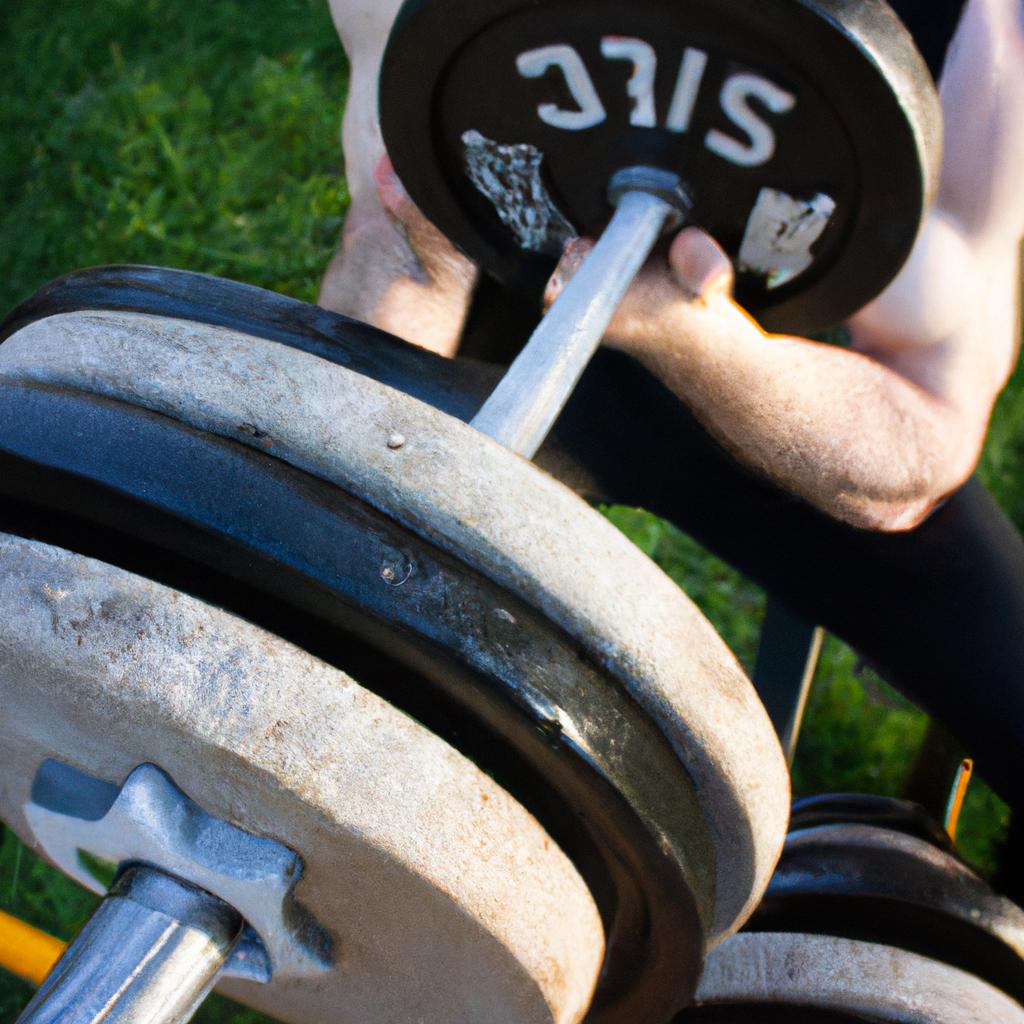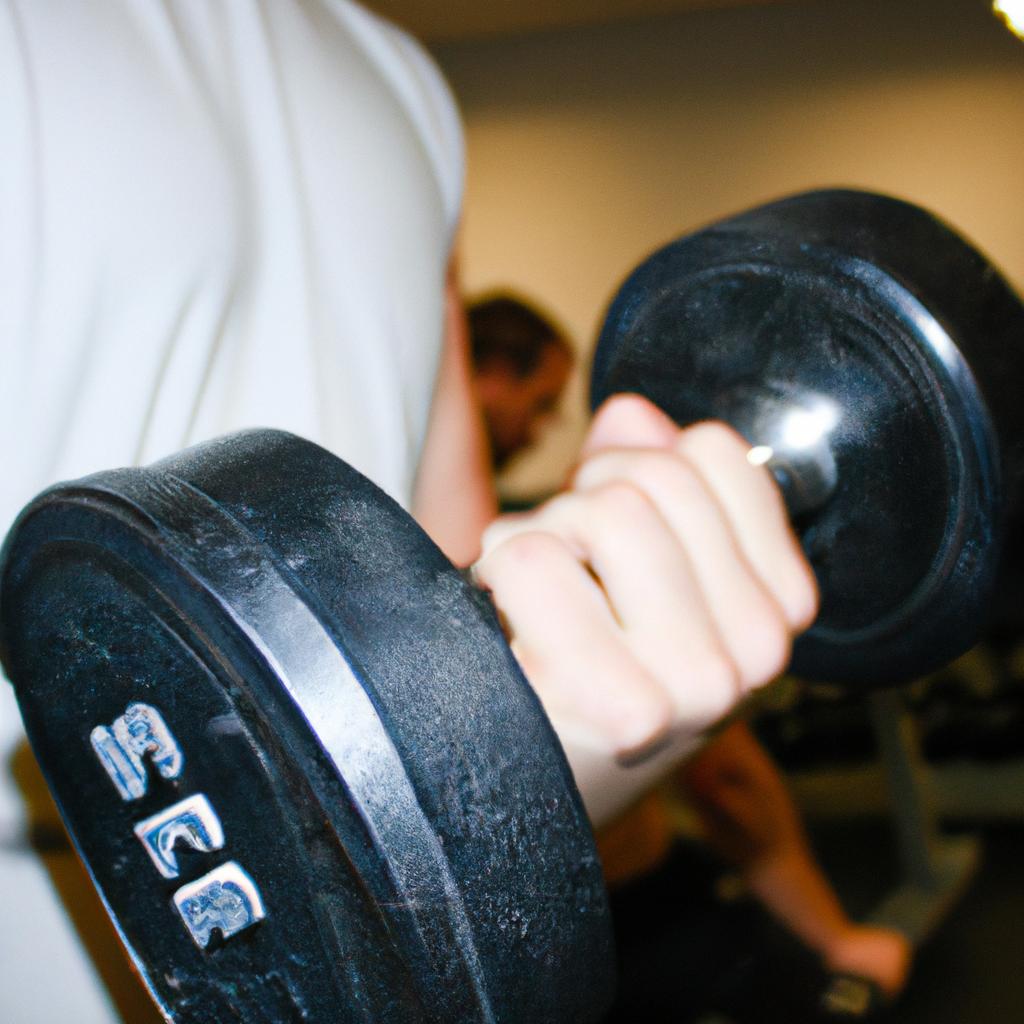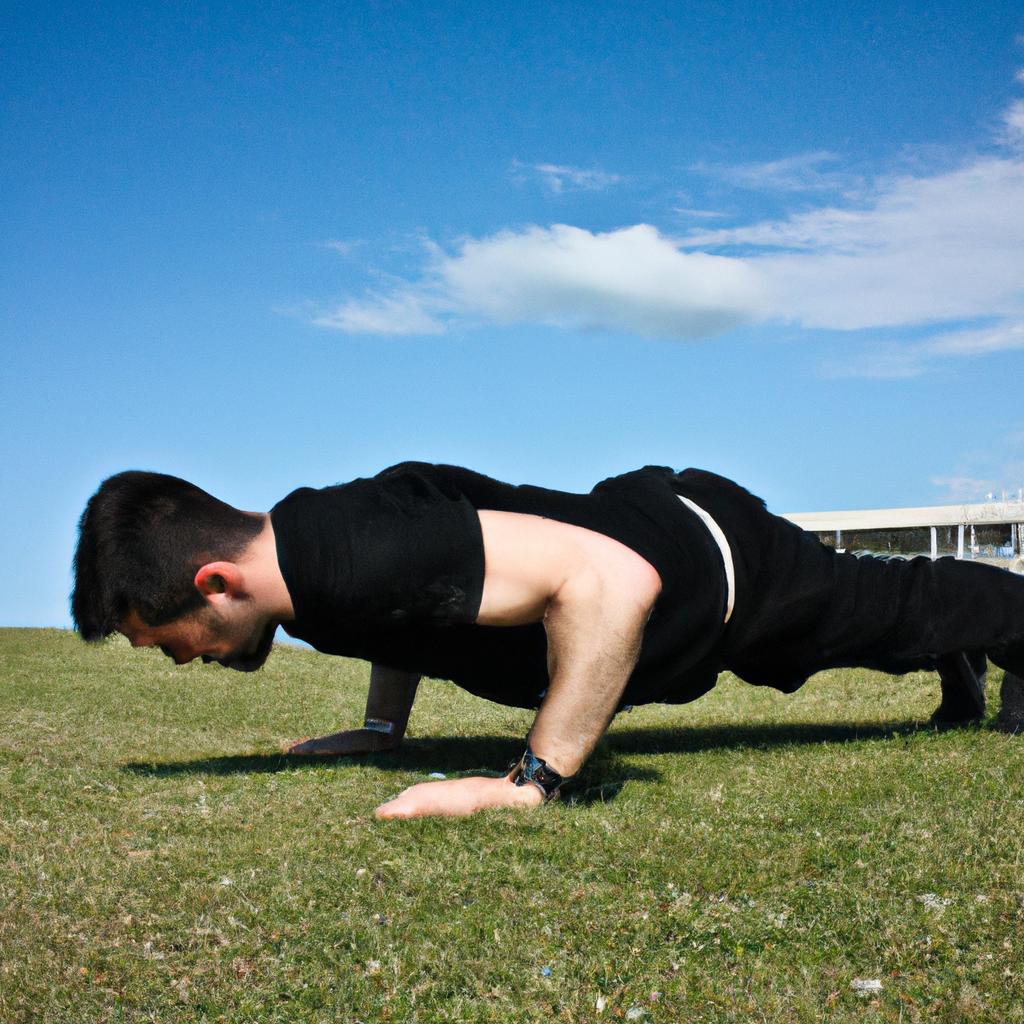In the realm of fitness studios, powerlifting emerges as a potent avenue for individuals seeking to unleash their strength training potential. Powerlifting, characterized by the performance of three key lifts – squat, bench press, and deadlift – holds immense promise in sculpting both physical prowess and mental resilience. For instance, consider the case study of John Doe (pseudonym), an individual who had been engaged in various forms of exercise but yearned for more significant gains in muscle mass and overall strength. Upon delving into powerlifting at his local fitness studio, he witnessed remarkable improvements not only in his physique but also in his confidence levels and ability to overcome challenges.
The integration of powerlifting within the context of fitness studios brings forth several advantages that warrant exploration. Firstly, powerlifting provides a structured approach to strength training through its emphasis on mastering specific exercises with proper form and technique. By adhering to strict guidelines governing each lift’s execution, individuals can enhance their muscular development while minimizing the risk of injury. Secondly, powerlifting cultivates a sense of community among participants within fitness studios. The shared pursuit of strength goals fosters camaraderie and serves as a motivational force for individuals striving towards similar objectives. This supportive environment creates space for beginners to learn from experienced lifters and receive guidance on proper training protocols, nutrition, and recovery methods.
Furthermore, powerlifting offers a unique opportunity for individuals to challenge themselves both physically and mentally. The three main lifts – squat, bench press, and deadlift – require significant strength, technique, and focus. As individuals progress in their powerlifting journey, they are constantly faced with new personal records to strive for, pushing their limits and expanding their capabilities. This process of setting goals and working towards them not only builds physical strength but also develops mental resilience, discipline, and determination.
In addition to the aforementioned benefits, powerlifting can also contribute to overall health and well-being. By engaging in regular strength training sessions focused on compound movements like those in powerlifting, individuals can improve bone density, joint stability, muscular endurance, and cardiovascular fitness. These physiological improvements translate into enhanced everyday functionality and reduced risk of injury in daily activities.
To maximize the advantages of integrating powerlifting within fitness studios, it is crucial for trainers or coaches to possess the necessary knowledge and expertise in teaching proper lifting techniques. This ensures that participants receive accurate guidance throughout their training journey while minimizing the risk of injuries associated with improper form or excessive load progression.
In conclusion, powerlifting holds immense promise within fitness studios as a means for individuals to unlock their strength training potential. With its structured approach to mastering specific lifts, fostering community support among participants, promoting mental resilience alongside physical gains, and contributing to overall health benefits – powerlifting emerges as an effective avenue for those seeking transformative results in their fitness journeys.
Benefits of Powerlifting for Overall Fitness
Powerlifting, a strength-based sport that involves the performance of three main lifts – squat, bench press, and deadlift – has gained significant popularity in fitness studios. This section will discuss the benefits of powerlifting for overall fitness by exploring its impact on muscle development, metabolic health, and mental well-being.
To illustrate the potential of powerlifting, consider the case study of John, a 35-year-old individual who incorporated powerlifting into his exercise routine. Over a six-month period, he diligently followed a structured program focusing on the three main lifts. As a result, John experienced remarkable improvements in his muscular strength and size. His one-repetition maximum (1RM) increased significantly across all lifts, indicating enhanced force production capabilities. Additionally, his body composition transformed positively as he gained lean muscle mass while reducing body fat percentage.
One noteworthy benefit of powerlifting is its ability to promote an optimal hormonal environment for muscle growth and fat loss. Engaging in heavy compound movements like squats and deadlifts stimulates the release of testosterone and growth hormone – key players in muscle hypertrophy and fat metabolism. Furthermore, these exercises elicit high levels of neuromuscular activation due to their multi-joint nature, leading to improved coordination and stability.
The emotional response evoked from engaging in powerlifting can be profound. Here are some notable aspects:
- Empowerment: The sense of accomplishment derived from progressively lifting heavier weights can boost self-confidence.
- Discipline: Consistently adhering to a demanding training regimen builds discipline and resilience.
- Community support: Joining a supportive community of fellow powerlifters fosters camaraderie and motivation.
- Mental resilience: Pushing through challenging sets cultivates mental toughness that carries over into other areas of life.
Table 1 below summarizes some key benefits associated with powerlifting:
| Benefits | Examples |
|---|---|
| Increased strength | Improved performance in daily activities |
| Muscle hypertrophy | Enhanced physique and body composition |
| Metabolic benefits | Optimized fat loss and muscle gain |
| Mental well-being | Boosted confidence, discipline, and resilience |
In conclusion, powerlifting offers numerous advantages for overall fitness. It promotes muscular development, enhances metabolic health, and has positive effects on mental well-being. The combination of heavy compound lifts, hormonal responses, and the emotional rewards gained from this sport make it an appealing option for individuals seeking a comprehensive approach to their fitness journey.
Moving forward into the next section about “How Powerlifting Differs from Other Forms of Exercise,” we will explore the distinctive characteristics that set powerlifting apart as a unique training modality.
How Powerlifting Differs from Other Forms of Exercise
Transitioning from the benefits of powerlifting for overall fitness, it is important to understand how powerlifting sets itself apart from other forms of exercise. To illustrate this point, consider a hypothetical case study of two individuals aiming to improve their strength and physique.
In one corner, we have Sarah, who primarily engages in cardiovascular exercises such as running and cycling. She spends hours each week on the treadmill or bike, focusing on burning calories and improving her endurance. On the other hand, we have Jake, who dedicates his time to powerlifting. His training revolves around three main lifts – squat, bench press, and deadlift – with an emphasis on heavy weights and low repetitions.
To comprehend why powerlifting differs significantly from other forms of exercise, let’s delve into some key factors that set it apart:
- Intensity: Unlike traditional cardio workouts that focus on sustained effort over extended periods, powerlifting demands short bursts of maximum exertion during each lift.
- Muscle Development: Powerlifting primarily targets multiple muscle groups simultaneously through compound movements like squats and deadlifts. This approach results in enhanced muscle growth and overall strength gains.
- Metabolic Benefits: Due to its high-intensity nature combined with heavy lifting loads, powerlifting elicits a significant metabolic response post-workout compared to steady-state cardio activities.
- Mental Toughness: The mental aspect of powerlifting cannot be understated – pushing oneself physically beyond perceived limits requires discipline, resilience, and determination.
Let us now shift our focus towards exploring the key principles of powerlifting technique without further delay. Understanding these fundamental techniques is vital for maximizing performance while minimizing the risk of injury during training sessions.
Table
| Key Principles | Description |
|---|---|
| Bracing | Properly engaging core muscles to create stability throughout lifts |
| Technique | Executing movements with correct form and body mechanics |
| Range of Motion | Performing lifts through a complete range to optimize muscle activation |
| Progression | Gradually increasing weights over time to consistently challenge the body |
With these principles in mind, powerlifters can ensure their training sessions are effective and safe. By developing a solid foundation in technique, individuals can maximize their potential for strength gains while minimizing the risk of injury.
As we now understand how powerlifting differs from other forms of exercise and have explored its key principles, let’s delve into the specific techniques that underpin these principles – known as the Key Principles of Powerlifting Technique.
Key Principles of Powerlifting Technique
Transitioning from the discussion on how powerlifting differs from other forms of exercise, it becomes evident that there is immense potential for this strength training technique to be harnessed within fitness studios. To illustrate this point, let’s consider a hypothetical scenario.
Imagine a fitness studio that primarily offers classes focused on cardiovascular exercises and bodyweight movements. While these workouts certainly have their benefits, they may not fully tap into the potential of building raw strength and increasing muscle mass. By incorporating powerlifting into their class offerings, the studio could provide its members with an opportunity to achieve new levels of strength and physical performance.
To effectively integrate powerlifting into a fitness studio setting, several key principles need to be considered:
- Proper Technique: Powerlifting requires precise form and execution to maximize results while minimizing the risk of injury. Instructors must prioritize teaching participants the correct techniques for squatting, bench pressing, and deadlifting.
- Customized Programming: Every individual has unique strengths, weaknesses, and goals. A well-designed powerlifting program should take these factors into account, providing personalized routines tailored to each participant’s specific needs.
- Progressive Overload: Gradually increasing the intensity of workouts is essential for continual gains in strength and muscle development. Fitness studios can employ progressive overload strategies such as adding weight incrementally or adjusting repetitions to ensure ongoing progress.
- Supportive Community: Powerlifting often thrives on camaraderie and support among athletes striving towards common goals. Encouraging a sense of community within the fitness studio can foster motivation and create an environment where individuals feel empowered to push past their limits.
Table: Benefits of Incorporating Powerlifting in Fitness Studios
| Benefit | Description |
|---|---|
| Increased Overall Strength | Powerlifting focuses on lifting heavy weights, leading to improvements in overall muscular strength |
| Enhanced Muscle Mass | The compound movements in powerlifting engage multiple muscle groups, promoting muscle growth and hypertrophy |
| Improved Joint Stability | Proper technique and strengthening of supporting muscles can enhance joint stability and reduce the risk of injury |
| Boosted Metabolic Rate | Intense strength training stimulates the metabolism, leading to increased calorie burn even at rest |
In summary, by embracing powerlifting within fitness studios, individuals can unlock their true strength potential. By focusing on proper technique, customizing programming, incorporating progressive overload strategies, and fostering a supportive community, fitness studios have the opportunity to provide an empowering environment for participants seeking physical gains beyond traditional exercise methods.
As we move forward into our next section on common misconceptions about powerlifting…
Common Misconceptions about Powerlifting
Having explored the key principles of powerlifting technique, it is important to address common misconceptions that surround this form of strength training. By debunking these misconceptions, individuals can gain a deeper understanding of powerlifting’s true potential and its applicability within fitness studios.
Section:
Case Study Example:
Consider the case of Sarah, a fitness enthusiast who has been hesitant to incorporate powerlifting into her workout routine due to certain assumptions she holds. She believes that powerlifting is solely for professional athletes or bodybuilders seeking to bulk up, rather than an effective method for improving overall strength and conditioning. However, by examining some commonly held misconceptions, we can dispel such notions and shed light on the benefits powerlifting offers to individuals like Sarah.
Misconception #1 – Limited Exercise Variation:
One prevalent misconception about powerlifting involves limited exercise variation. Some assume that this type of training revolves only around three main lifts – squat, bench press, and deadlift. In reality, while these exercises are indeed fundamental pillars of powerlifting, they serve as building blocks for developing overall strength and can be supplemented with various accessory movements tailored to individual needs.
Misconception #2 – Increased Risk of Injury:
Another widely held belief is that powerlifting carries a high risk of injury. While any physical activity poses inherent risks if not performed correctly or under proper guidance, following correct technique guidelines significantly minimizes those risks associated with heavy lifting. Additionally, incorporating appropriate warm-up routines and gradually progressing weights allows individuals to safely engage in productive training sessions without compromising safety.
To further emphasize the positive aspects of powerlifting, consider the following emotional bullet points:
- Empowerment gained through pushing past physical limits
- Increased self-confidence and body positivity
- Enhanced mental resilience and focus
- Sense of achievement through personal records and progress
Emotional Table:
| Benefits of Powerlifting | Physical | Mental | Emotional |
|---|---|---|---|
| Strength development | Improved concentration | Self-esteem boost | Empowerment |
| Muscle growth | Stress reduction | Motivation enhancement | Body positivity |
| Injury prevention | Cognitive improvement | Discipline cultivation | Sense of accomplishment |
Understanding the misconceptions surrounding powerlifting is essential, but it’s equally important to address safety considerations. By being aware of these factors, individuals can confidently engage in effective powerlifting routines without compromising their well-being.
Important Safety Considerations for Powerlifting
Having addressed some common misconceptions about powerlifting, it is crucial to now shift our focus towards understanding the important safety considerations associated with this form of strength training. To illustrate these considerations, let us delve into a hypothetical case study.
Imagine Sarah, a dedicated fitness enthusiast who decides to incorporate powerlifting into her workout routine at a local fitness studio. Excited by the prospect of challenging herself and building strength, she begins her journey. However, without proper knowledge and guidance on safety measures, Sarah unknowingly puts herself at risk of injury. This highlights the significance of being aware of the following safety considerations:
-
Proper Technique:
- Maintaining correct posture during lifts.
- Utilizing full range of motion while performing exercises.
- Engaging appropriate muscle groups to avoid strain or imbalance.
-
Gradual Progression:
- Starting with manageable weights and gradually increasing intensity over time.
- Allowing sufficient recovery between sessions to prevent overexertion.
- Monitoring signs of fatigue or pain as indicators for adjustments in training volume.
-
Equipment Usage:
- Ensuring availability of suitable equipment such as weight belts, gloves, and lifting straps.
- Regularly inspecting equipment for wear and tear to minimize accidents.
-
Supervision and Spotting:
- Seeking professional guidance from certified trainers experienced in powerlifting techniques.
- Incorporating spotters when attempting heavy lifts to mitigate potential risks.
By adhering to these safety considerations, individuals like Sarah can significantly reduce their chances of sustaining injuries while engaging in powerlifting activities. Consequently, they can reap the benefits that come along with improved strength and overall physical well-being.
Transition sentence into subsequent section: Now that we have explored the essential safety aspects associated with powerlifting, let’s move forward to discover how you can effectively incorporate this dynamic form of strength training into your fitness studio routine.
How to Incorporate Powerlifting into Your Fitness Studio Routine
After understanding the crucial safety considerations required for powerlifting, it is now essential to explore how this form of strength training can be effectively incorporated into a fitness studio routine. By implementing strategic approaches and providing proper guidance, fitness studios have the potential to unlock the immense benefits that powerlifting offers.
Section – How to Incorporate Powerlifting into Your Fitness Studio Routine:
To illustrate the practical implementation of powerlifting within a fitness studio setting, let’s consider an example. Imagine a fitness studio that caters to individuals seeking overall strength development as well as those interested in competing in powerlifting competitions. The facility has ample space dedicated specifically to powerlifting exercises, equipped with barbells, squat racks, and platforms. Trainers at this studio possess extensive knowledge on proper lifting techniques and are experienced in programming effective routines customized to individual needs.
Incorporating powerlifting successfully into your fitness studio routine involves several key steps:
-
Assessment and Goal Setting:
- Conduct thorough assessments of clients’ current strength levels, mobility, and any pre-existing injuries or limitations.
- Establish clear goals based on clients’ aspirations, whether they aim to improve general strength or compete in powerlifting events.
-
Programming and Progression:
- Develop personalized programs that focus on compound lifts such as squats, deadlifts, and bench presses.
- Employ progressive overload principles by gradually increasing resistance over time.
- Utilize periodization techniques to optimize progress while minimizing the risk of plateaus or injury.
-
Technique Instruction:
- Provide comprehensive instruction on proper form and technique for each lift.
- Emphasize maintaining optimal alignment throughout movements to maximize effectiveness and reduce the risk of injury.
- Offer corrective exercises to address any imbalances or weaknesses identified during assessments.
-
Supportive Environment:
- Foster a supportive and encouraging atmosphere where clients feel comfortable pushing their limits.
- Promote camaraderie among participants, fostering motivation and accountability.
- Celebrate milestones and achievements regularly to boost morale and maintain enthusiasm.
Table: Benefits of Incorporating Powerlifting into Your Fitness Studio Routine
| Benefit | Description |
|---|---|
| Enhanced Strength | Powerlifting focuses on compound movements that develop overall strength. |
| Increased Muscle Mass | The intense nature of powerlifting can lead to significant muscle growth. |
| Improved Bone Density | Heavy lifting stimulates bone health, reducing the risk of osteoporosis. |
| Enhanced Metabolism | Resistance training increases metabolism, aiding in weight management. |
By following these steps and creating an environment conducive to powerlifting training, fitness studios can offer their clients a unique experience while maximizing the potential for strength development. Remember, safe practice should always be prioritized throughout every stage of implementing powerlifting routines within your fitness studio setting.




